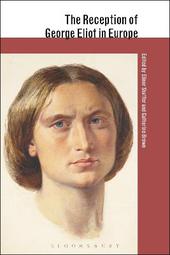
|
The Reception of George Eliot in Europe
Hardback
Main Details
Description
George Eliot (born Mary Ann Evans, 1819-1880) was one of the most important writers of the European nineteenth century, as well as a pioneering translator of challenging and controversial Continental thinkers, and an influential editor and essayist. Although such novels of provincial life as Adam Bede, The Mill on the Floss and Middlemarch have seen her characterised as a thoroughly English writer, her reception and immersion in the literary, intellectual and political life of Europe was remarkable. Written by a team of leading international scholars, The Reception of George Eliot in Europe is the first comprehensive and systematic survey of Eliot's place in European culture. Exploring Eliot's deep knowledge of German literature and thought, her galvanizing influence on women novelists and translators in countries as diverse as Sweden and Spain, her travels in Holland, Germany, Switzerland, Austria, the Czech Lands, Italy, and Spain and her friendship with leading figures such as Mazzini, Turgenev, and Liszt, this study reveals her full stature as a cosmopolitan writer and thinker. A film of her Italian Renaissance novel Romola was one of the first to circulate in Europe. Including an historical timeline and a comprehensive bibliography of primary and secondary sources and translations, The Reception of George Eliot in Europe is an essential reference resource for anyone working in the field of Victorian Literature or the European nineteenth century.
Author Biography
Elinor Shaffer is a Fellow of the British Academy, (Hon.) Professor, University College London, UK, and Senior Research Fellow, Institute of Modern Languages Research, School of Advanced Study, University of London. She is the Director of Research and Series Editor of the Reception of British and Irish Authors in Europe, of which The Reception of George Eliot in Europe is the twenty-first volume. She is also author of 'Kubla Khan' and The Fall of Jerusalem: the Mythological School in Biblical Criticism and Secular Literature (1980), which begins with Coleridge and concludes with a study of Daniel Deronda; author of the Introduction to the Everyman Middlemarch; and "The Sound of Grass Growing": Eliot in Weimar', a lecture to the Goethe Society. She is a founder-member of the British Comparative Literature Association and founder-editor of Comparative Criticism. Catherine Brown is Head of the English Faculty and Senior Lecturer in English at the New College of the Humanities, London, UK. She is the author of The Art of Comparison: How Novels and Critics Compare (2011), which considers the nature of comparison per se using the case studies of George Eliot's Daniel Deronda, Lev Tolstoy's Anna Karenina, and D.H. Lawrence's
ReviewsBegun in 2002, Bloomsbury's "The Reception of British and Irish Authors in Europe" series offers comprehensive, erudite coverage of geopolitical or translation contexts for individual authors. This volume on how George Eliot was received across hostile, friendly, or historically shifting borders over a tumultuous 150 years addresses numerous questions: Who cared that "he" was a woman? Who didn't? Who published her? Which works? When? In English or translation? How good were the translations? How many copies sold? Read in libraries? How much political, social, or literary favor or hostility appears in the texts-or the margins? The essays vary in length, depth, density, and variety of authorship, method, and style, but readers favoring a particular geography or work will find surprises. Eliot was sensitive to social stratification, so this reviewer found the essays on the shifting geopolitical contexts of Germany and former Soviet bloc countries the liveliest and most layered. Italians of course fixated on Romola-but who knew that Hollywood exploited both romantic Gish sisters, Lillian and Dorothy, to make it into a 1924 blockbuster? The volume includes a vast bibliography. Summing Up: Recommended. Upper-division undergraduates through faculty. * CHOICE * Important sociopolitical connections emerge from the pictures of individual countries, giving the reader a broad view of not only the responses of Eliot's contemporary audience, but the far-reaching ripples of her impact over time. This combination of narrow focus on single countries, the detailed examination of Eliot's works in translation, and the high-level overview that emerges of the nineteenth-century literary landscape will be of most use to more advanced students and scholars who wish to dig deeply into Eliot's legacy and enduring relevance. * American Reference Books Annual * An interesting account of the reception of Eliot's work across Europe ... We find much insight on Eliot's creative progress and intellectual background. * Revista de Filologia Inglesa *
|